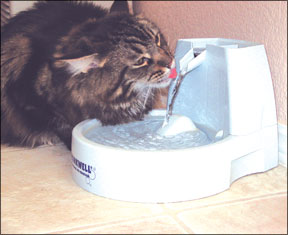Despite their relatively small size, your cats kidneys play a huge role in many life-sustaining processes.These two bean-shaped little organs – situated just behind the cats rib cage, one on either side of its spine – filter waste from the blood. In doing so, they also help control blood pressure and regulate the amount and


Bev Caldwell
288
chemical consistency of fluid in the bloodstream. In addition, they produce a variety of vitally needed hormones and enzymes and contribute to the production of red blood cells. Since about 25 percent of the blood that enters your cats circulatory system with each heartbeat travels directly to the kidneys, their well-being is essential to your cats health.
Unfortunately, feline kidneys are vulnerable to a wide range of serious disorders. Indeed, kidney (renal) disease is a major cause severe illness and death in cats, especially after the age of seven years.
Waste Removal
Perhaps the most important role that the feline kidneys play involves the removal of metabolic waste products – such as urea, mineral salts and toxins – from the blood, says James Flanders, DVM, an associate professor of clinical sciences at Cornell Universitys College of Veterinary Medicine. This is accomplished by kidney tissue containing hundreds of thousands of tiny filtration units called nephrons.
When waste-laden blood enters the kidneys through the renal artery, it moves through progressively smaller vessels until it reaches these minuscule filters. The cleansed blood – about 95 percent of the total fluid volume – then circulates back to the heart for yet another round trip through the body. Meanwhile, the remaining fluid, containing the waste products, is passed along as urine from the kidney to the bladder to be excreted.
Acute Versus Chronic
When this sophisticated filtration system malfunctions, says Dr. Flanders, potentially toxic wastes start to accumulate in the recirculating bloodstream. If the proper balances of water, minerals and electrolytes (such as sodium and potassium) is not maintained, serious complications may affect other organs.
A high risk for kidney disease may be inherited, but the great majority of cases are acquired, and they fall into two broad categories: acute renal failure, a severe condition with a relatively sudden onset that becomes apparent over a period of a week or a month; and chronic renal failure, a disorder that persists over an extended period of time, possibly for several years.
Acute renal failure most commonly results from the ingestion of substances that are toxic to the kidneys, such as antifreeze, pesticides, cleaning fluids and certain human medications, such as ibuprofen. If diagnosed at its earliest stage and treated promptly, organ damage resulting from acute renal failure is potentially reversible, and an affected cat can go on to enjoy a normal life span.
Chronic renal failure, however, is an incurable condition that mainly afflicts middle-aged and older cats. It occurs when 75 percent or more of functional kidney tissue has been destroyed and replaced by scar tissue, possibly due to infection and inflammation caused by such conditions as dermatitis and dental disease. Unlike acute renal failure, the onset and progression of this condition is gradual and irreversible, extending over many months or years. In some cases, little can be done to prolong the life of a cat diagnosed with late-stage chronic renal failure; in other cases, a cat may survive for several years following diagnosis.
Veterinary Diagnosis
The early signs of failing kidneys, says Dr. Flanders, include a marked increase in water consumption and urination, weight loss, observable decline in appetite, and in some cases, occasional vomiting. If these signs are observed, the owner should seek immediate veterinary consultation.
If kidney disease is suspected, a veterinarian will first perform a complete blood test (CBC) a serum chemistry panel, and a urinalysis. The CBC can detect the presence of anemia or systemic infection, and the serum chemistry panel can reveal elevated blood levels of substances such as blood urea nitrogen (BUN) and creatinine that would normally be shed in the urine. These high levels will indicate that the kidneys are not adequately filtering metabolic wastes. The urinalysis will provide additional information on the extent of kidney damage and whether an infection might be responsible for the diminished kidney performance. Further tests – involving X-rays, ultrasound and even a tissue biopsy – may be required to confirm a tentative diagnosis of renal failure.
Treatment Options
Treatment for acute renal failure, says Dr. Flanders, is generally determined by the factors responsible for the condition – if, that is, they can be identified – and the extent of kidney damage sustained. If caused by any type of urinary tract blockage, for example, the obstruction must be removed immediately. If ingestion of antifreeze or a human medication is diagnosed, intravenous infusions must be administered without delay to correct fluid and electrolyte imbalances in the blood.
On the other hand, the great majority of chronic renal failure cases will be treated more conservatively – the objective being to provide palliative therapy and to postpone the progression of kidney dysfunction insofar as possible. Special low-protein diets and supplemental fluid therapy (given subcutaneously or intravenously) may prolong the lives of many cats with chronic renal failure. In rare cases, surgical removal of a malfunctioning kidney may be recommended, but only if the remaining organ is strong enough to carry out the kidneys’ many tasks by itself.
In recent years, notes Dr. Flanders, significant progress has been made in two treatment areas. One is hemodialysis – a procedure that removes liquid and chemicals from the blood that the kidneys would routinely remove if they were functioning normally. The other is feline kidney transplantation techniques. Survival rates are now as high as 70 percent at some veterinary centers, and owners can expect their animals to live one to three years or longer following a kidney transplant.
Dr. Flanders points out, however, that these sophisticated procedures are not appropriate for all ailing cats, and they are available in only a few areas of the United States. Moreover, he notes, transplants are costly, ranging somewhere between $8,000 and $12,000 for the procedure itself, plus the expense of immunosuppressive drug therapy for the remainder of the organ recipients life.



